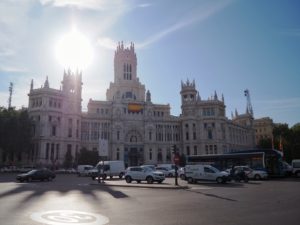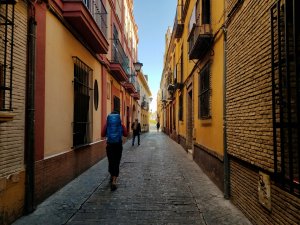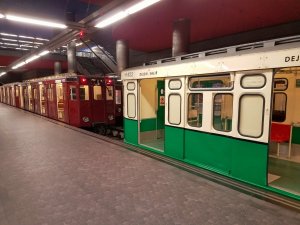Madrid, Spain is an excellent candidate for solo travel. The vibrant city attracts millions of tourists each year, and it’s position as the Capital of Spain elicits a cosmopolitan vibe throughout the city. The popularity of Madrid does not mean it should be discounted as a destination for solo travel.

Whether you’re in Madrid as a budget backpacker or with a little more spare change in your pocket, visiting as a solo traveler is a fantastic way to spend time in the city. There is a reason to visit Spain’s capital for every traveler. This guide will help in your preparations and expectations for visiting Madrid:
Tourist Highlights
Madrid’s position as a national capital is an obvious tourist attraction. The location of Madrid in the center of Spain is an added travel bonus. It is essentially at the geographic crossroads of Spain, and this has positioned Madrid as an ideal place to start a solo travel journey into the culture and action of the country.
For any traveler, be that a solo backpacker or someone in town for a short travel stay, there are a few highlights of Madrid that cannot be missed on a first visit. These are some of the main tourist attractions in Madrid:
Royal Palace of Madrid
The Royal Palace of Madrid is an imposing sight and the official residence of the King of Spain. Although the Spanish Royal Family wields virtually no power or authority – they seem to be shrouded in scandal more often than politics – it still exists. For whatever reason, Spain still has a king.

Without getting into the politics of it – if you’re not a Spanish citizen, does it really matter? – the Royal Palace of Madrid is a great place to visit at the right time. Portions of the palace are open to visitors throughout the year (with holiday and other exceptions).
Unfortunately, admission costs €13. There is a free admission period each day for EU citizens and citizens of certain Latin American countries. For the rest of us, don’t expect a discount.
The Royal Palace is spectacular, but the admission price isn’t really in line with a solo travel backpacker budget in Madrid. Photography is also not allowed inside. Take the time to see the exterior of the palace, and wander the surrounding grounds. Skip the entrance fees and the crowds.
Prado Museum
The Prado is the most famous museum in Spain and one of the most well-known art museums in the entire world. Famous artists represented include Goya, Raphael, Titian, El Greco, Rembrandt and many more. The Prado is home to some of the world’s most famous works of art and the world’s largest collection of Spanish art.
If you’re even slightly interested in art or museums, the Prado is a must-see for a first timer in Madrid. The benefit of visiting the Prado for solo travel in Madrid is seeking out the art that interests you and going at your own pace. To state the obvious, art museums don’t appeal to everyone. A solo traveler can freely spend an hour or half a day in the Prado.

The only downside to visiting the Prado is the no photography rule. While it makes sense with flash, it puzzles me that some art museums allow non-flash photography and others fiercely prohibit snapping pictures of any kind.
Visiting the Prado is a good deal. Admission is only €7.50, and entrance is free from 6-8 PM, Monday-Saturday and 3-5 PM on Sundays. My advice is to arrive at least an hour before the free period begins. The crowds and lines are quite large.
Travelers with an especially keen interest in art will love the area around the Prado. There are two other art museums, the Thyssen and the Reina Sofia, nearby. These galleries contain art that is not featured in the Prado, such as modern and contemporary art, as well as art from other historical periods.
The Prado (and other nearby art museums) is on nearly every Madrid travel guide for a reason. It is a terrific display of Spanish history and culture at a reasonable price.
Other Notable Museums in Madrid
Madrid’s status as a large city, an old city and national capital means there is a lot of culture and history in a single area. For travelers and tourists wanting to explore a little deeper into that culture, here are some other good museums in Madrid:
- National Archaeological Museum – prehistoric, ancient, medieval and Moorish history in Spain
- Museum of the Americas – great museum for insight into Spain’s once-illustrious empire
- Naval Museum – Spain once had the greatest navy in the world
- Madrid History Museum – local history galore
- Museum of the Royal Mint – for coin lovers and fellow numismatists, this place is a must!
- Dozens more including museums of tapestries, anatomy, rocks, transportation and so on
Almudena Cathedral
Almudena Cathedral, officially Santa María la Real de La Almudena, is the center of Catholicism in Madrid. As a heavily Catholic city in a largely Catholic nation, that’s a significant distinction for a church.
Visiting Almudena Cathedral doesn’t have to be a pilgrimage, and it’s not as incredible as Seville Cathedral. It’s just a large, pretty church that holds an important cultural position in the city. The cathedral is also conveniently located directly across the small Armeria Plaza from the Royal Palace.

Almudena Cathedral is big and beautiful, the kind of church that is popular for a reason. The best part of this church is that admission is free – like visits to all religious sites should be.
Puerta del Sol
All tourists in Madrid will eventually find themselves standing in Puerta del Sol. The de facto center of Madrid, Puerta del Sol is where all roads in the city meet. The large plaza is teeming with people, shops and street performers.

To be frank, the area around Puerta del Sol isn’t that interesting. If the plaza was empty, it would be a cool sight. As it is, Puerta del Sol is incredibly crowded. This is great for people watching, but travelers need to mind their pockets and bags around here.
If you’re into shopping at the same stores (or very similar ones) that are found in every big city in the world, this is the place to go in Spain. And if you need to purchase a silly souvenir, this is the area.
There’s also the famous bear statue – The Bear and the Strawberry Tree – where tourists congregate waiting to take a picture. It’s a fun statue with a little bear craning up to the top of a little tree, but apparently it is representative of Madrid. The statue has definitely become a symbol of the city.

Puerta del Sol is one of those places you have to see on a first trip to Madrid. It’s on all the travel guides, and it’s certainly a “thing to do” in Madrid. It’s a lot like Times Square in New York City – it’s a center of tourism with shops of overpriced crap and an absurd amount of people. Puerta del Sol is only useful for people watching and ticking something off a list.
I enjoy getting away from dense crowds when I travel solo, and that’s generally easy to do in Madrid. Puerta del Sol is one exception. It’s a place you kind of have to see at least once, but that’s probably enough. See it, use it as a reference point to get around and then explore the rest of the city.
Plaza Mayor
Where Puerta del Sol is the center of Madrid, nearby Plaza Mayor is the historic main square. Plaza Mayor is equally as touristy, but it is a much more attractive scene. The buildings appear older and are certainly more photogenic.

Plaza Mayor is attracts crowds. Despite being smaller than Puerta del Sol, Plaza Mayor isn’t usually as busy. The square isn’t as open, and it’s also free of public transit stops.
Plaza Mayor has a few restaurants with outdoor seating into the square. These are almost certainly going to have a tourist element about them, including tourist prices, but the location is hard to beat. If you’re going to splurge for one touristy meal in Madrid, this is a good spot.
Live Sports
Controversy aside, bullfighting is popular in Spain. It is often seen as an artform and has deep cultural ties to the country. Madrid is home to the largest bullfighting ring in Spain, Las Ventas. The stadium is located in Salamanca, with the season running from March-October and the peak in late Spring.
Attending a bullfight may not be for everyone. Let’s just say that the bull rarely wins and doesn’t live to fight again. If you’re up for it and in Madrid during the season, there are few activities to experience local culture better than attending a bullfight.
Far more popular and world-renowned than bullfighting is soccer. Or futbol, football, whatever you want to call it. Madrid is home to one of the world’s best, biggest, and wealthiest soccer clubs, Real Madrid. Atletico Madrid is the second best team in town, and both clubs play in enormous stadiums.
Madrid has other teams, too, including two other clubs playing in Spain’s top soccer league. In other words, soccer in Madrid is a really big deal.
If you can get tickets to a Real Madrid game – well, if you can afford them – this would surely be an incredible experience. Atletico tickets are also going to be expensive and in high demand, though slightly more attainable.
Even if you can’t make it to watch one of the famous teams, catching a game for one of the smaller teams will be an exciting affair. Soccer in Spain is serious business, and the atmosphere at the games is exciting. Even if you’re not a soccer fan, casual sports fans will thoroughly enjoy this opportunity.
Parks & Green Spaces in Madrid
Madrid has a fair amount of parks. If you count public gardens and other (calm and quiet) public spaces, there are a lot. But there are two parks worth checking out for tourists in Madrid.

Casa de Campo
The largest park in Madrid is Casa de Campo. The enormous park, located near the Royal Palace, was originally on royal land, but today it is open to the public. The park is predominantly green and natural, but it is dotted with historical landmarks, points of interest and even an amusement park.
Casa de Campo is the perfect area to get away from the city without actually leaving the city. Solo travel in Madrid may be overwhelming for some, and others may just want to escape the constant grind of big city traffic and crowds.
Casa de Campo is made for wandering. Pack a helping of jamón, bread, cheese and a cold Mahou, and it’s a great area to spend half a day. At over 4000 acres, it is full of trails and quiet spaces. Casa de Campo is the ideal retreat in Madrid for nature, hiking and a decent view of the city.
El Retiro
The prettiest park in Madrid is El Retiro. This park, located in Salamanca, is more organized and planned than Casa de Campo. The lake in the middle is popular for paddle boats, street vendors selling cheap (probably counterfeit) goods and just hanging out.
Although it’s not as “untouched” as it’s larger counterpart, El Retiro is an equally pleasant escape from the city. The paths are perfect for an easy walk. It’s quiet. And the design of the park is attractive, too.
Best Neighborhoods for Solo Travel Wanderings in Madrid
Centro is the oldest district in Madrid. As the name clearly implies, it is also the central district in the city. This is where visitors will find most of the major tourist attractions in Madrid, such as the Royal Palace, Puerta del Sol and Plaza Mayor.
Aside from the obvious highlights of Centro, the district is also home to some of the coolest neighborhoods (wards) in Madrid. The Cortes and Embajadores neighborhoods are especially interesting.

This is the area made for solo travel in Madrid. It’s apt for aimless wandering, and the narrow streets are lined with interesting shops and hundreds of tempting places to pop in for a drink or a bite to eat.
The age of this part of the city is apparent in the architecture. Most of Madrid has older buildings, but a lot of the city looks fairly new or recently renovated. The small side streets of Centro is the area to find slightly older buildings lining stone streets that were never intended for cars. It’s definitely the prettiest part of the city and the best area to get a distinctly Madrid feeling when walking around.
For solo travelers who want to get a real feel for Madrid and find a less touristy part of the city, there are plenty of options. Madrid is a huge city by population and area. There are several neighborhoods to walk around aside from Centro, though it is the most conveniently located and most photogenic. Each district and neighborhood is unique from the next.
I especially enjoyed walking around Salamanca, which is an upscale district to the east of Centro. Salamanca is nicer and more expensive, but that is mostly for people living in Madrid. It still has its fair share of cheap food, and the whole area is a pleasant place to take a stroll.

Solo travel in Madrid would not be complete without checking out areas less frequented by tourists. During my three visits to Madrid, I thoroughly enjoyed exploring more of the city. In addition to Centro, I recommend checking out Retiro, Prosperidad, Salamanca and Charmartin to see another side of Madrid.
Madrid is much more than Centro and much more than these few districts. Solo travelers who like to get away from the crowds and tourist attractions will find Madrid an ideal place to wander.
Eating & Drinking in Madrid
The best activity for tourists – be that backpackers, families, couples or solo travel in Madrid – is eating. Food in Madrid is excellent. Eating in the city offers a wonderful blend of cuisine from around Spain. There are also a lot of international options thanks to Madrid’s size and international status.
Solo travel foodies in Madrid don’t have to worry about the city lacking authentic local eats. Madrid also has plenty of local specialties, and pretty much everything is exceptional.

For first-timers in Madrid, there are a few important things to note: This is not the part of Spain where tapas are free and famous, and this is not the paella capital of Spain, either. Lastly, jamón is everything. Eat it. Those are the main points.
For a thorough breakdown of costs, eating cheap, local dishes, drinking the good stuff and a lot more, read the Hangry Backpacker’s Guide to Eating & Drinking in Madrid.
The Best Time to Visit Madrid for Solo Travel
Summer is the most popular time to visit Madrid. This is when the bulk of visitors, tourists of all types, show up en masse. Summer is ideal for the traveler who wishes to travel Spain in the sunshine and include a beach visit or two.
Winter can be more challenging in Spain. It’s not like Winter in Siberia, but mountainous areas are snowy. Winter in Spain also sees popular attractions alter hours and even some smaller tourist businesses shut down for the season.
For independent travelers and solo travel in Madrid, the best time to visit is Spring or Fall. The weather in the city ranges from cool to warm and is pleasant overall. The low season has yet to inconveniently alter operating hours, but the numbers of tourists are significantly lower than the peak season.
Mid-Spring or early Fall is ideal for solo travelers who still want some sunshine and possibly a bit of beach time. It would be wise to expect rainy days and plan accordingly, though. The nice days are made even better by smaller crowds, especially in Fall. The weather in late Fall is inconsistent and unreliable, but the crowds are significantly smaller.
Spain’s climate varies a lot considering the relatively small geographical area. For instance, Summer in the north is pleasant and even cool at night. On the other hand, Summer in Seville is notoriously hot. Madrid is warm during the summertime, occasionally very hot.
For the most part, Madrid is a fairly temperate city. It’s never Bangkok hot or Moscow cold. Solo travel is easiest when there are fewer tourists, and this is the main factor for deciding when to visit Madrid.
How Long Should You Stay in Madrid?
Madrid is a really cool city, but how long is long enough?
Madrid is big, and it’s a national capital. And it’s old. All of these things mean there’s a lot to do. In fact, there is as much to do in Madrid as you want to, so it just depends where your interests lie.

History & Culture Enthusiasts
For travelers interested in history and culture, you could easily spend weeks in Madrid. There are enough museums, galleries, ruins and historical sites to occupy your time for quite a while.
Outdoorsy Travelers in Madrid
Travelers interested in nature and outdoor activities won’t find much need to stay in Madrid for long. It’s a big city, pretty much a concrete jungle, so any sort of hiking, trekking or other outdoor fun will require nature-loving travelers to go elsewhere.
Foodies in Madrid
Food-focused and hungry travelers will love Madrid. There are thousands of bars and restaurants, and the gastronomic scene in Madrid is absolutely top notch. A few days is adequate to get a thorough sampling of cuisine in Madrid. A week of eating in Madrid would be an awesome, thorough way to taste the city. You’ll probably get fat, though, so maybe do some walking.
Solo Travelers in Madrid
Madrid is an excellent choice for solo travel or those who want to escape tourist traps. Yes, there are a lot of tourist attractions (and tourists, at times) in Madrid, but the city is large enough that solo travelers in need of an authentic detour can easily get lost.
There are also several great day trips from Madrid that are ideal for solo travel, such as Segovia and El Escorial. A week is long enough to stay in Madrid if you plan to use the city as a base for day trips, otherwise 3-4 days is enough to see the sights and do some wandering.
Ultimately, how long you should stay in Madrid depends where your travel interests lie. A couple of days is not enough, but a week is probably pushing it for most people. Somewhere right in the middle, about 3-4 days, will be the optimal length of stay in Madrid for most travelers.
Transportation in Madrid for Tourists
Transportation in Madrid is easy and efficient. The city is largely walkable, and there aren’t that many steep hills. Public transportation within the city is easy to use and reasonably priced. Transportation to nearby cities, destinations farther away in Spain and international destinations are also pretty easy to reach from Madrid.
For a full, thorough breakdown of getting around Madrid, including airport transfers, bus/subway prices and more, read the Hangry Backpacker’s Guide to Transportation in Madrid for Tourists.
Is Madrid Safe for Solo Travel?
This is a surprising question that comes up a lot before and after my trips. People are always curious about safety abroad, as if I was heading off to trek through cartel territory or an active warzone.
I guess it’s a reasonable question if it keeps coming up. So is Madrid a safe place to travel solo?
To my American friends, Madrid is far, far safer than most of our big cities. Hell, most of the world is statistically safer than Chicago, New Orleans, St. Louis, Detroit, D.C, Baltimore – should I continue? No, that’s depressing. While tourists aren’t at danger of being hacked away in American cities, rest assured knowing that Madrid is not a dangerous place to travel.
Like any city in the world, travelers should always exercise caution and remain aware of their surroundings. And getting stumbling drunk late at night is not something I would advise.

The only instance in Spain’s capital where I felt uncomfortable was in Plaza Mayor where a non-local vendor got mad that I didn’t want to buy his cheap, fake sunglasses. I walked away when he yelled, and he left me alone. Otherwise, I had no issues whatsoever.
So, yes. Madrid is totally safe, and solo travel in Madrid is totally safe. In fact, traveling alone might be even safer because you don’t stick out and scream “I’m a tourist!” like the mere presence of a tour group. Solo travel is the best way to see Madrid, and it’s very safe to do so.
Best Hostels in Madrid for Solo Travelers
Madrid is made for solo travel. For backpackers and other long-term travelers, social interaction or someone to explore the city with (or a dinner companion!) is an important factor to consider.
Thankfully, Madrid has hundreds of hostels, and most of them are less than €20 for a bed in a dorm. Private hostel rooms can be as low as €25. These are a few of the great hostel options in Madrid:
Is Madrid Worth Visiting for Tourists?
Madrid is not known as being the most culturally rich, quaint or picturesque city. It’s known more as the big city in Spain. If it’s not spectacular, is it worth your time?

Yes and no. Madrid is not as photogenic as Seville, and it’s not as lively as Barcelona. That doesn’t mean you should skip it. There’s a lot to be said about the national capital and largest city of a country as old as Spain. The cultural impact from those distinctions means there is a lot of important stuff going on. It means there will be a lot of interesting sites and places to see.
Madrid has its pros and cons. More extensive impressions and whether or not I think Madrid is worth visiting for tourists are coming soon.
Madrid is a cool, fun city with tons of attractions and activities for tourists to enjoy. Solo travel in Madrid comes with the bonus of getting around easier, the ease of wandering, exploring the city beyond the touristy areas and traveling cheaper.

Whether it’s a brief stay or a longer trip, Madrid has something for every traveler. There are few cities with such a high concentration of culture and history that also have fantastic food and are incredibly clean. Madrid is the gateway into Spain for solo travel, and it’s an excellent starting point for anyone heading to the country for the first time.
This post contains affiliate links. We may receive a small commission from any purchases through these links – at no extra cost to you. The Hangry Backpacker is also a participant in the Amazon Services LLC Associates Program, an affiliate program designed to provide a means for us to earn commissions by advertising and linking to Amazon.com.



























You must be logged in to post a comment.